The high voltage LM317HV series of ICs will allow to go beyond the traditional voltage limits of an LM317 IC and enable controlling supplies that may be as high as 60V.
0-60V Regulation with a Single IC LM317
Therefore now you can build a universal 0-60V regulated power supply circuit loaded with all the essential features of a work bench test power supply circuit.
Normally a standard LM317 IC power supply is designed to work with inputs not exceeding over 40V, which implies that you cannot enjoy the features of this wonderful linear device for inputs that may be higher than this limit.
Probably the developers noticed this drawback of the device and decided to upgrade the same with its improved version LM317 HV which is specifically designed to handle voltages upto 60V, meaning now you can exploit all the special features of an LM317 IC even with inputs higher than its earlier specifications.
This makes the IC extremely versatile, flexible and a true friend of all electronic hobbyists who are always looking for an easy to build yet rugged and powerful workbench power supply circuit.
I have explained how this high voltage LM317 HV design is created for the proposed 0-60V variable power supply circuit operations.
Pinout Configuration of LM317HV
The following diagram shows the pinout diagram of the device LM317HV

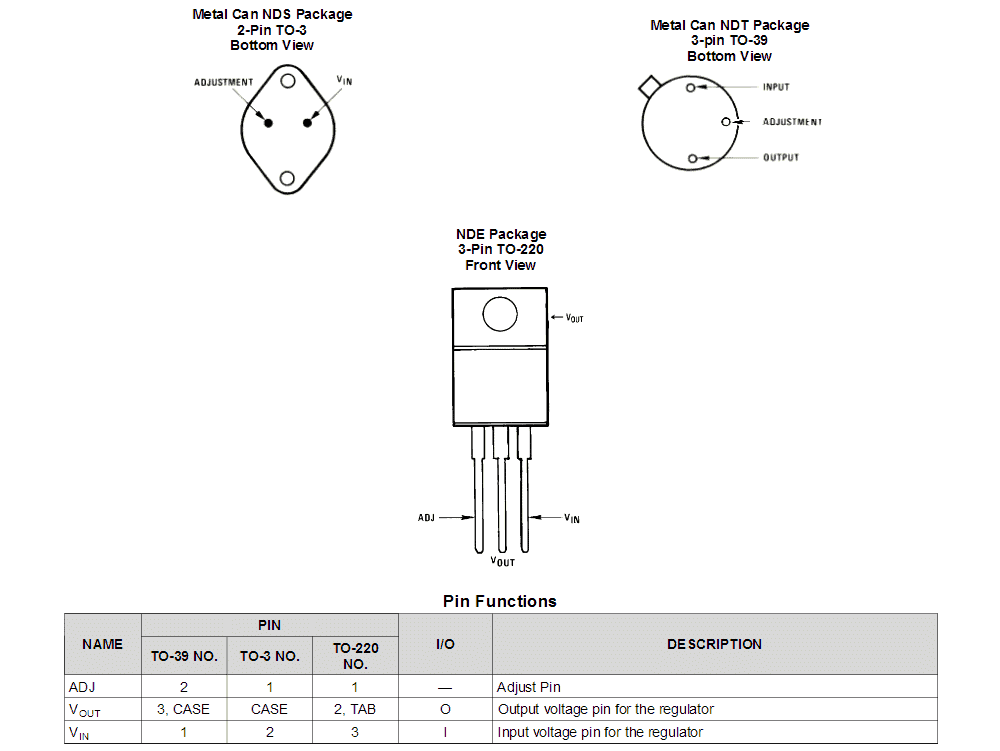
Image Courtesy: http://www.ti.com/lit/ds/symlink/lm117hv.pdf
LM317HV 0-60V Regulated Adjustable Variable Power Supply The Design
The next diagram shows the standard LM317HV 0-60V variable regulated power supply circuit, in fact this configuration may be universally applicable to all LM317/LM117, LM338, and LM396 IC family.
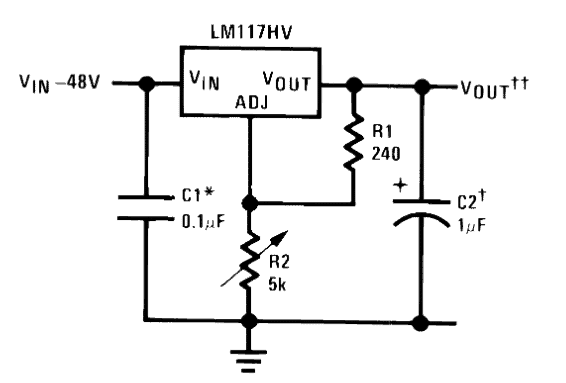
Referring to the design taken from its datasheet we can see that the variable resistor or the potentiometer is specified as a 5K pot, but actually this should be much higher than this value, may be around 22K for achieving a complete 0 to max adjustable output.
The input shows a 48V but we can go a bit higher than this and use upto 56V DC as the input, but please do not stretch it to full 60V as that would mean operating the device at the verge of its breakdown limit and this could make the IC vulnerable to damage.
In case you operate it with a 60V input or slightly above this, then short circuiting the output terminals accidentally could cause an instant damage to the IC, that's why it is not recommended to force the IC to work at its full throttle.
Below this limit, the internal short circuit protection feature could be expected to work normally and safeguard the IC from any possible short circuiting at the output.
C1 may be included only if the shown circuit stage is over 6 inches away from the bridge rectifier and the associated filter capacitor network
C2 is optional and may be included only to improve performance which would help eliminating all possible spikes or transients in the DC line.
For achieving a fixed regulated voltage, R2 could be replaced with a fixed resistor with respect to R1, this may be calculated using the following formula:
Vout = 1.25(1 + R2/R1),
where 1.25 is the fixed reference voltage value generated by the ICs internal circuitry.
You can also use the following software for calculating the same:
Adding Protection Diodes and Bypass Capacitor
The next diagram shows how a couple of diodes may be added to the basic voltage regulator design for reinforcing the circuit with extra protection, although this may not be too crucial.
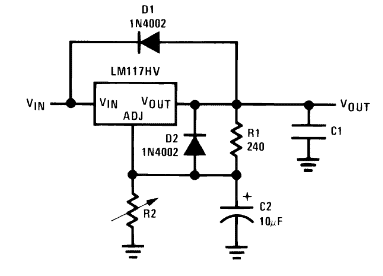
Here D1 protects the IC from the discharge of C1 due to an accidental short circuit of Vin with the ground line, while D2 does the same against C2 discharge.
The role of C1 is already explained in the previous paragraph, C2 is used as a bypass capacitor. C2 may be included to further improve the output DC regulation as it would help to eliminate all sorts of ripple voltages that might appear across the output.
Adding a Simple Current Limiter Stage
Although the LM317HV is internally restricted to produce not more than 1.5 amps at the output, in case the output current is required to be strictly below this limit or any other desired limit below 1.5 amp, then this feature could be achieved by adding a straightforward BC547 stage as shown below:
The diagram also shows the complete LM317HV high voltage 0-60V variable regulated power supply circuit in a pictorial format.
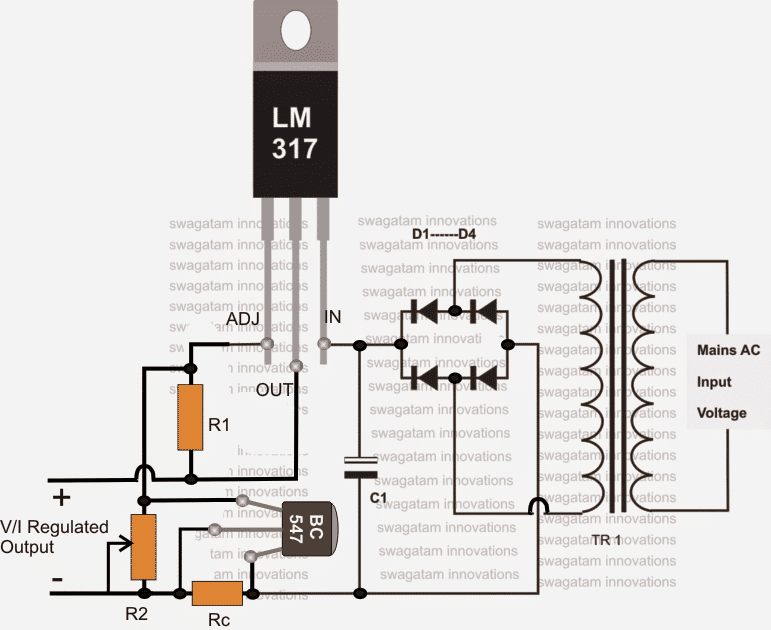
Here R1 refers to 240 ohm, R2 could be a 22k pot, and Rc may be calculated using the following formula for achieving the required current control feature:
Rc = 0.6/Max current limit value.
For example if the maximum value is selected to be 1 amp, then the above formula could be calculated as:
Rc = 0.6/1 = 0.6 ohms
the wattage of the resistor could be calculated as given under:
0.6 x 1= 0.6 watts
The diode in the bridge rectifier should be preferably 1N5408 diodes for ensuring a smooth rectification with no heating issues.
C1 may be anything above 2200uF/100V, although lower values will also do for lower current loads and for non critical loads which do not mind slight ripple factor in the line.
The transformer could be a 0 - 42V/220V/2amp.
The 0 - 42V is recommended because after rectification and smoothing this final DC could exceed a little over 55V.
The next article we might possibly discuss regarding the various application circuits using the LM317HV high voltage regulator IC.
PCB Layout (with reference to the second diagram)
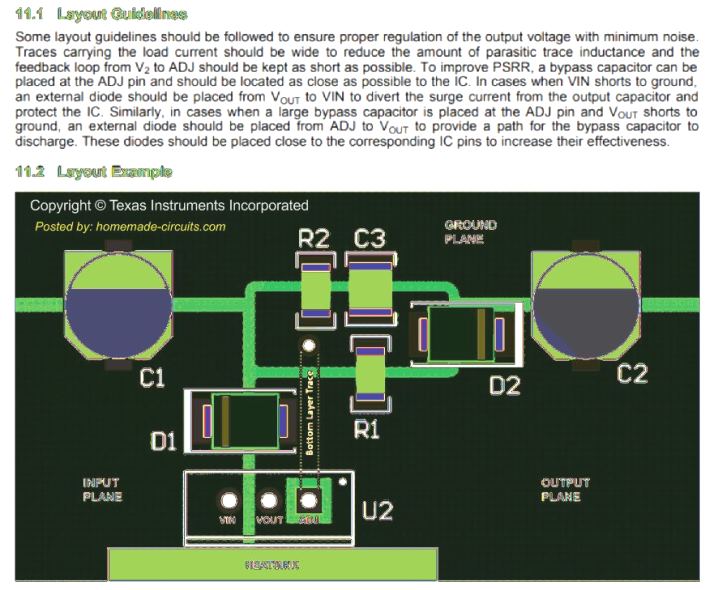

Wanna make a diy 0-60v 0-20 amp power supply using 3055 transistor and lm317
Kindly help for a nice accurate and powerful circuit
You can try the second last circuit from the following article:
https://www.homemade-circuits.com/lm317-with-outboard-current-boost/
Dear Mr. Swagatam
I need 53 V input and 12 -15 V output for a 2 lights and webasto diesel heater ( 5 -7 A)
I would like to make circuit as you give us on March 27, 2022
I have 6 nos TIP 2N3055
do i need to make 3 X parallel LM317HV?
If need, how to add 3 x lm317HV in parallel. Just put in parallel with no resistors between
Input is from lifepo4 batteries 48 -53 volts do i need capacitor at the input?
R1 is 240 OHM , how many W
R2 could be a 22k pot.- how many W
Thank you very very much for your help.
Regards, MATJAZ
Hi Matjaz,
If you are using 2N3055 transistors then adding 317 in parallel is not required. For 7 amp current only 3nos of 2N3055 are enough.
If you want to connect 317 in parallel, first build a single 317 circuit with resistor and pot, then add two more 317 in parallel to the first one.
Make sure to install all the 3 ICs on a single common heatsink.
Capacitor will not be needed at the input.
240 is 1/4 watt
pot can any ordinary pot.
Hello,
I would like to try your power circuit for a project I am working on, but would like to ask a few questions before I attempt to build the circuit. The input voltage will be input 110/120VAC and I am looking for a variable output of 12VDC – 20VDC 4a-8a. Can you recommend correct components for this?
Hi, to implement this circuit you will need a 120V to 20 V transformer. After this you can rectify the 20V AC from the transformer and use it as the input DC for the above explained LM317 circuit.
For increasing current you can modify the basic circuit into the following design:
https://www.homemade-circuits.com/wp-content/uploads/2022/04/high-current-LM317-power-supply-circuit.jpg
Hello sir, I check the circuit but the seller gave me wrong ic instead of lm317, but I got 5.62 at the output. So what could be the actual problem or can it be the tiny wire I used for the circuit.all my connection are correct. My Rc should be 0.6ohm and is not found in my place so I used two 1ohms 1 watts in parallel and 0.22 ohm’s in series with the resistor
as you instructed becausee 0.1 ohm’s is not found, C1= 6800uf 25v, R2=22kpot, R1=240 ohm’s.
Hello Youngking, that seems strange.
With a 22K pot and 240 ohm resistor the output could be varied from 1.25V to 30V. Something is not right in your circuit. I suspect the IC itself may be faulty.
Instead of 317 you can try a fully transistorized circuit as explained in the following post, which will give you the same results as LM317.
How to Design a Bench Power Supply Circuit
Good morning sir , sir I built this 0- 60 variable power supply the one using lm317 and bc547, but my output is 0.15 when turn my multi meter to left hand side written 200. But if I still turn it down to 20 my output will be 2.18. my transformer is 12-0-12v, what will be the problem no components is heating up or may be you didn’t indicate the Bc547 pins because the facing is confusing I also attached pictures on the values I get with the multi meter.
Hello Youngking, this is one of the simplest designs and cannot go wrong. A problem can arise only if there’s a fault in the connection or the IC itself is faulty. The BC547 pins are clearly indicated in the pictorial diagram, the emitter pin is shown connected with the ground.
You can try making the basic design first, and check the response, if still it doesn’t work then either your connections are not correct or the IC itself is faulty.:
https://www.homemade-circuits.com/wp-content/uploads/2016/08/317hv-5.png
Dear sir,
Please sir, I intend to get 1.5A output from the circuit by removing the Bc 547 stage.
1. What else do I have to do or modify to get the 1.5A output?
2. Can I add filter capacitor at the regulated output?
3. Is the heat dissipation of the lm317 directly proportional to the difference between the input Voltage and output voltage like in the case of 2n3055 in one of your variable power supply circuits you told me about?
Thank you for your help, sir
Hi Godfrey,
Getting 1.5 amp from LM317 can make it very hot. You can simply replace it with an LM338 for getting 1.5 amps easily.
1) Just replace LM317 with LM338, or use two LM317 in parallel and mount them over a single common heatsink
2) You can add a capacitor at the output
3) Yes, since LM317 is also a linear regulator the heat dissipation will be directly proportional to the difference in the input/output voltages.
Dear sir,
Please sir, how can the circuit be modified to have two outputs 12V and 5V at 1.5A?
Hi Godfrey,
you can adjust the pot to get 12V output, and then use a 7805 IC to convert the 12V to 5V. However you cannot get 1.5 V simultaneously from the two outputs. For this you may have to replace the LM317 with a LM338.
Okey sir, thanks alot. I appreaciate.
You are welcome!
I wanted to build a variable power supply but unfortunately I don’t have the voltage regulator lm317hv.
I need 60v 20a output.
So what should I use instead of lm317hv?
For 60v
You can try the following concept:
Variable Voltage, Current Power Supply Circuit Using Transistor 2N3055
LM317HV isn’t available in this place where I live. So can you provide an alternative of this please
There’s no other easy alternative for LM317HV
Okey sir, thank you for your responses, but the 1 ohm’s will it be 1 watts.
Yes you can use 1 watt
Good day sir, I hope you are doing well. My questions is concerning the 0-60v variable power supply that uses lm317H v (1) so if I use transformer of 14v/220 v/amps unknown won’t I get reasonable output of about 30v. (2)- the calculation of getting the RC, let say I go with your calculation which say’s 0.6/1=0.6 ohm’s for the resistor then the wattage is 0.6×1=0.6watt. I know 0.6 ohm’s is not found in my area so any substitution for such ohm’s. Thanks so far for your effort
Hi Youngking, if you are using a 14V transformer, then the output after rectification and filtration will be 14 x 1.41 = 19.74V
Yes RC will be 0.6 Ohms for a cut off current of 1 amp. Wattage calculation is also correct.
To build the 0.6 ohms you can use two 1 ohms in parallel and then add a 0.1 ohm in series, or you can try some other similar combination.
Dear Swagatam:
Greetings.
My LiFePO4 battery pack is being designed for 72 volts (nominal) with 23 cells in series and 58 cells in parallel amounting to 25kwH. I will be needing a charger at 230v AC input, and can take care of the demand for 78v at 100 amps. I am unsure if such a circuit can be built as a single unit. Can you help with a circuit, where I can put two or three modules in parallel with each of them at 78v, to arrive at the desired current rating? Thanks in advance.
Dear Madhav, a charger circuit with auto cut off can be built but you will require a transformer which can convert the 230V into 78V 100 amps for the batteries
Hi Swagatam;
I have test for LM317; input is 23 V output is 12 V load is 0.32 A. LM317 is overheating. My I have your opinion. Thank and regards
Hi Suat, yes if the input/output voltage difference is high then any linear regulator will heat up, you can do nothing about it except connect a large heatsink, or do fan cooling. A capacitive current dropper is the best method which can be connected to 23V AC and then rectified for the motor and meter.
Okey Sir,
then since my source transformer output is 23 AC and it is necessary to place capacitor after the rectifier and then DC output is 33 DC. That is over burden to LM317 or even 7812. As far as I understand your evaluation, I should either change my transformer or lower the AC input source to about 15 V. So I should search the second choice first. Kind Regards
Hi Suat, yes using a 12V transformer will quickly solve the heating issue.
Hi Swagatam;
by considering above statement; “C1 above or min. 2200 mF”, let’s use 2200 or 6800 mF then in the aspect of output dc voltage, result would be same or 6800 is would be more effective? Regards
Hi Suat, the higher the value of C1 the better will be the filtration. 2200uF is a reasonable value, but higher values can be tried for improving the output DC further.
Hi Again Swagatam;
Sorry just to completely understand the matter let me ask; for instant I have transformer input 220 and output 24 V and 100 VA. (I think app. 4 Amps) When I use 2200 mf capacitor as a filter after diodes I measure about 34 V output. In case I would have used 3300 mF then the gain would be more output voltage or more stable voltage? and also please comment what about the output current would be the same, less or higher?-thanks and kind regards
Hi Suat, the gain will be more stable voltage at higher loads. Max current will remain 4 amps only, but higher capacitor values will ensure that the output doesn’t drop with increasing loads upto 4 amps.
Hi Swagatam;
Thanks a lot the above info is highly precious for me. Then please advise if it is possible to place the capacitors as parallel to increase the capacity. For instance to use 2 of them as 2200 mF 35 V plus 3300 mF 63 V. Or capacitors voltage values should be the same too? Regards
Hi Suat, you can put the capacitors with different voltages in parallel, but the minimum voltage of a capacitor should be at least 1.5 times the DC output of the power supply. Higher voltage values than this will be OK, no issues.
Thanks Swagatam;
Power supply input 220 AC output is around 22 V DC but after bridge diode and capacitor that arises to 33 V DC. So, then I should consider 22 x 1.5= 33 V or 33 x 1.5= 50 V? For instance I have 35 V capacitor That will be any issue or tolerable? Regards
Hi Suat, a 35V capacitor can be too risky and might blow off if accidentally the DC across it exceeds above 35V. That is why, for better safety a 1.5 times more value is recommended. So a 50V capacitor is recommended for a 33V supply.
Please suggest me a circuit diagram of a 60v 30a (1800watt) variable power supply.
And also give a 1800 watt power supply diagram. Because I’m not able to find it nearby
You can try the following circuit:
https://www.homemade-circuits.com/lm317-variable-switch-mode-power-supply/
replace the Q1 transistor with three IRF9540 mosfets in parallel, mounted over a common heatsink
Also make sure to use very thick wires for the inductor L1.
First test the original low current version, if you succeed with it, only then go for the upgrade
I want to make a diy 0-60v and 0-20a variable power supply, using the diagram, the voltage issue has solved, but what about the amps?
I have tip3055 transistor, can I use them anyhow?
And what should be the wattage to power this kind of variable power supply?
You can do it by implementing the following design:
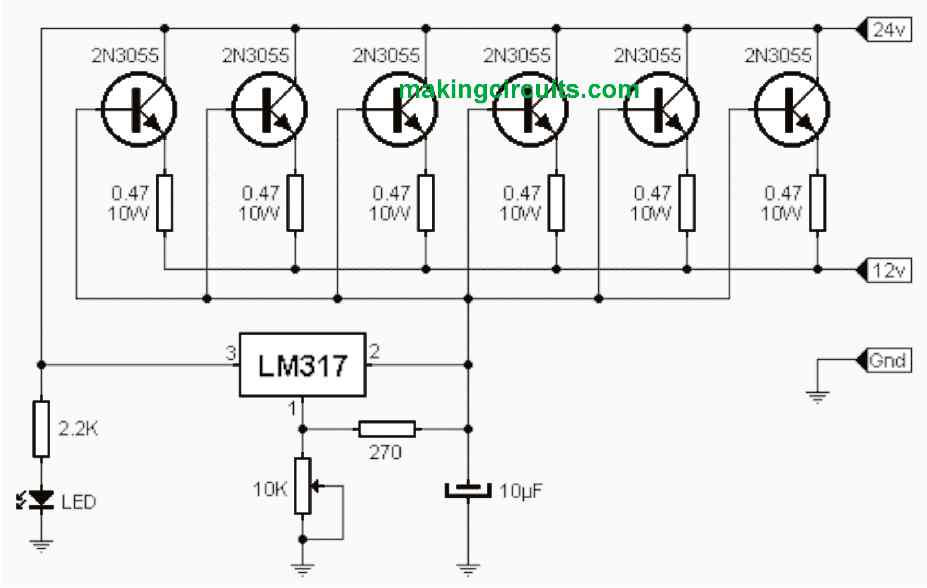
Is it capable to give 0-60v and 0-20a output?
And because of I want a output voltage of 60v, should I use lm317hv instead of lm317?
Yes that’s correct! You must use LM317HV
If you use minimum 4nos of 2N3055 then 20 amp can be achieved.
hi swagatam
In this circuit can i use multiple lm317 hvt. How can i add cc control pot for 100 ma to 10 a. i m trying to make power supply 0-55 v and 10 amp.
thank you
harish
Hi Harish, in the second last diagram you can modify the Rc and the BC547 stage using the method shown in the following article:
https://www.homemade-circuits.com/simple-current-sensor-circuit-modules/
yes you can use multiple ICs in parallel just make sure to mount them closely over a common aluminum heatsink
hi swagatam
i love ur website sir it is very informative.In above circuit if i want to add cc control how can i add.also if i want 10 amp can i add 7 lm317hv in parellel.I m trying to build 0-60 V 10 A with cc and cv control.
thank you
harish patel
Thank you Harish, yes you can connect the ICs in parallel and mount them over single common heatsink. However for 10 amps you may have to use 10 ICs in parallel. It is required to keep a 0.5 Amp margin for each IC, otherwise the ICs can heat up a lot.
for CC you can apply the second concept from the following article:
https://www.homemade-circuits.com/how-to-build-simplest-variable-power/
hi swagatam
do i have to use two seprate lm317hv for cc and cv ?
thank you
harish patel
Hi Harish, no need of using separate devices for the CC and CV, the BC547 will be able to provide the CC feature for the all the ICs combined, and the pot will enable the CV for the common output.
Please see the example layout in the second last figure above.
Hello Swatatam, I changed the regulator to LR12 and tested it. Since the maximum current of my application is about 20mA, I decided that there is no problem with the rating of this regulator. The result is good. R1 = 1,5K, R2 = 100K/VR, C2=0.1μF, The output voltage could be adjusted up to about 70V. Thank you very much for your help. 73 de JF1BQS
That sounds great Yukihiru! Glad you could achieve the required results so easily, please keep up the good work!
Hello Swatatam, I enjoy ham radio and homebrew in Japan. The vacuum tube type regenerative receiver I made requires a stable 50V voltage to stabilize the regeneration. When using this LM317HV, I think that R1 = 240Ω and R2 ≒ 9400Ω are all right, but how much capacity do you think C1 needs? The maximum current is about 10mA. Please let me know if you have any other notes too. Yukihiro
Hello Yukihiro, glad to know about your ham radio interest. You may find a few ham radio circuits in this blog too!
The capacitor around the LM317 is actually not critical at all, if your source power supply is a good DC, and as long as your LM317 circuit is not situated far away from the power supply DC source. So C1 could be any value, but the voltage of C1, and C2 must be typically 1.5 times or 2 times higher than the maximum voltage that could be achieved from the LM317 output
Hi Swagatam, Thank you for your comment. I was relieved with your suggestion. Since the DC source is in the same box, there is no problem with distance. I tested with C1 = 0.1µF and C2 = 10µF and got good results. But I found another problem. The voltage applied to this LM317HV will be about 80V until the active of the vacuum tube stabilizes. It hasn’t failed so far, but I’m worried about the future, so I’m looking for a another regulator that can use a higher voltage input. I feel like I can use Microchip’s LR12N3-G. Your blog is easy to understand and very good contents. Thanks again. Yukihiro
You are welcome Yukihiro! yes 80 V seems to be a bit high for the LM317HV as the max limit is 60 V.
LR12 will do but the current output will be only 100 mA, if it suits your application, then no problem…
Mr. Swagatam, last weekend I successfully built a multi-volt power supply using an LM338 regulator and a 10k ohm pot to power a mini subwoofer amp. I used the existing transformer of the non-working subwoofer(output current unknown). I set the pot to give me 24vdc out. I was getting pretty decent sound at a very low volume setting. But when I turned the volume up a few notches to test, the sound abruptly stopped. I discovered that R1 had burned up. I’m not sure if the pot was ruined or not. Instead of killing the voltage, it increased it from 24vdc to 39vdc, so I may have ruined the subwoofer amp as well. Since I have no info on the transformer’s output(it’s fairly large), I didn’t know how to determine the wattage for the resistors. Any suggestions on how I can beef things up? Thanks for any help.
Buck
Hello Buck, that looks strange, R1 is protected by the pot resistance, and if the pot resistance is reduced to zero, the output voltage would also reduce to 1.25V, so apparently there’s no chance of R1 burning, unless the IC itself is faulty or duplicate this can never happen. Please check your IC output voltage response to confirm if the IC is working.
Thank you, sir. Will check it out, and let you know.
No problem!
Mr. Swagatam, I checked the LM338, and I measured 38.9 vdc on all three legs. I had removed the burned out R1 and the pot, which was sparking when I turned it, so It looks bad too. By the way, I have the LM338 fastened to the back plate heat sink, but electrically isolated from it with insulators. I ordered a pack of five of those and they look new. FYI, the R1 I used was 1/2 watt.
Buck
Mr. Buck, 38V on all pins clearly indicates the IC is damaged, so probably the IC also needs to be changed
Wow, that’s bizarre. I’m trying to figure out what caused the failure in the first place. I turned up the volume a little, which drew more current from the power supply, which then fried R1 and apparently the pot as well, and probably the amp. You said that R1 failing should’ve only caused the IC to shut down, not open up. If the same holds true for the pot, then it looks like the IC may have been faulty to begin with. I’ve seen a few sources say there are fake LM338’s out there, so I’m wondering now if I got some. If anyone else has experienced this, I would like to hear about it. Thanks again, Mr. Swagatam. I really appreciate the guidance.
Buck
Actually I meant to say the opposite, it is the R1 and the pot which got damaged due to a faulty IC, otherwise R1 has no chance of failing.
Mr. Swagatam, I just wanted to let you know that I finally got my power supply to work. I burned up a total of three LM338’s from two different suppliers, two R1 resistors and one pot. On the fourth try, I decided to not solder the LM338 onto the board, but instead butt crimped three flying leads to it and then soldered those to the board. I was wondering if maybe I was damaging them during the soldering process. I also decreased the ac voltage of the transformer and went from 24 vdc to 15 vdc by using the center tap instead of the outer leads. Even at 15 vdc, the subwoofer puts out so much bass that I can’t turn it up very high. I just wanted to say thanks again for your help. Your website is a great resource.
That’s great Buck, however a normal soldering will not damage the IC unless the leads are continuously touched for more than 10 seconds. Also, 24 V is perfectly within the specs of the IC so again that is fine. Anyway, glad you could sort it out finally.
Hello sir, please I need a 90v high voltage regulator input to 0-24v output. Thanks
Sorry I do not have this at the moment
Hai sir…
I have few doubts in Protection diode using in LM317…
If we use protection diode D1,D2 in lm317 .it will protect the o/p short circuit…
If vout short circuit to gnd what happen to ic..ic will damage or not…
In our college lab many varaible power supply damages due to o/p short circuit…
So by using protection diode in lm317 it will help or not..
Hi Kesav,
LM317/LM338 ICs are internally protected from short circuit, overload current and from over heating (thermal protection) so it is virtually indestructible.
the indicated protection diodes are actually not required, because its job is to protect the IC if a short circuit is made from the input side of the IC with a high value charged capacitor connected at the output side.
Since the above possibility is quite unlikely, the shown protection diodes actually do not own much importance, and is not relevant to output short circuit situation….
Okay sir…
But when o/p short circuit happens the IC get more heating…
I’m so affair whether the ic will damage…
If there any protection circuit available pls share me sir…
Bcs many power supplies are got damaged..in college lab..
I’m using 18-0-18v Transformer 1Ampere…
How much size heat sink required for IC317
LM317 already has all the protections in-built so no external means are required, when it heats up beyond a certain level the IC will shut down automatically until the heat returns to lower levels.
you can use the following type of heatsink, and make sure the IC is original, duplicates may not have the above mentioned protections…
https://3.bp.blogspot.com/-C_5QfBQJ9DM/WlnIPyaVA1I/AAAAAAAARaA/kGOJApt7Uo4qU-coCYtfbJJzE5o2CevZgCLcBGAs/s1600/208265.jpg
Thank u sir….
I’m using ic company name is ST…
Is this company good sir…
yes it is good, but the problem is that duplicate companies can also put fake prints, but no problem mostly it should be original
Sir I have some led driver which input is 24 volt AC and out is 54 volt dc.i want to opret it without transformer.can it possible 220 v drop into 24 volt AC or any other ideas.please suggest me.thanks in advance.
Ashok, that may be possible only through a 24V transformer or through another 220V to 24V SMPS…..
however you can try a capacitive power supply also, using the following concept:
https://www.homemade-circuits.com/2016/07/scr-shunt-for-protecting-capacitive-led.html
replace the zener with a 24V zener in the design
Hello Mr. Swagatam.
Is it possible to change this circuit giving a boost in amperage?
Thanks.
Hello Amadeu, yes that may be possible by implementing the following concept in the above design
https://www.homemade-circuits.com/2016/10/lm317-variable-switch-mode-power-supply.html
Can’t it be done by adding multiple tip3055
Power transistor in parallel?